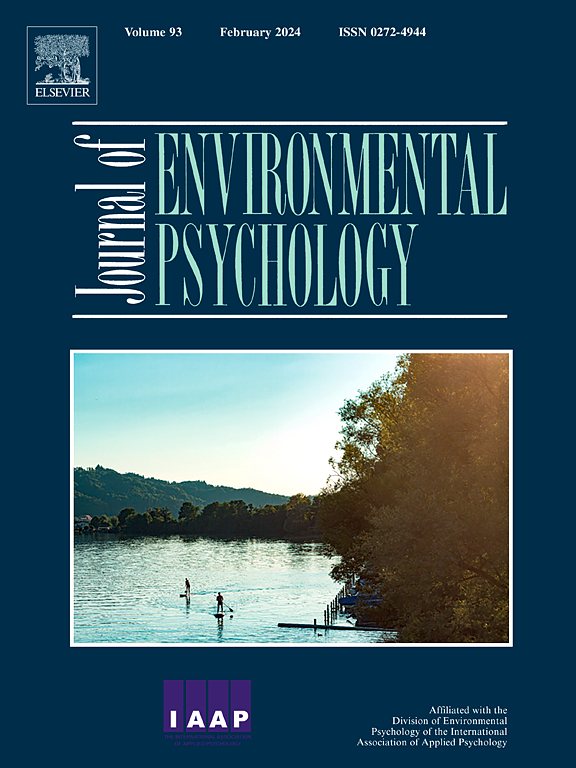热浪、空气污染、绿地和蓝色空间对抑郁症状发生率的个体和综合影响
IF 7
1区 心理学
Q1 ENVIRONMENTAL STUDIES
引用次数: 0
摘要
气候驱动的温度对健康的危害已经得到了广泛的研究,但对心理健康的具体影响,特别是在空气污染和蓝绿色可达性的背景下,在很大程度上仍然未知。本文使用中国健康与退休纵向研究(CHARLS)的数据,研究热浪、空气污染和蓝绿空间对抑郁症状的个体和协同效应。逻辑回归分析显示,暴露在热浪中与抑郁风险增加4.2 - 14.0%有关。此外,PM2.5、PM10、CO和SO2的环境浓度每增加10 μg/m3,抑郁症的优势比(or)分别增加25%、13%、1%和55%。我们还发现PM2.5、PM10、SO2、CO的浓度与热浪暴露的蓝色和绿色空间的缺乏之间存在正相互作用,在乘法(乘积项的or >;1)和加法(RERIs >0)尺度上都是如此。同时暴露在热浪和空气污染中或缺乏绿色和蓝色空间比单独暴露更容易出现抑郁症状。本研究提倡将热浪、空气污染和蓝色/绿色基础设施纳入气候适应型心理健康政策制定中。本文章由计算机程序翻译,如有差异,请以英文原文为准。

Individual and combined effects of heatwaves, air pollution, green spaces, and blue spaces on depressive symptoms incidence
The health hazards of climate-driven temperature have been extensively studied, but the specific effects on mental health, especially given the backdrop of air pollution and blue-green accessibility, remain largely unknown. Here we investigate individual and synergistic effects of heatwave, air pollution, and blue-green space on depressive symptoms, using data from the China Health and Retirement Longitudinal Study (CHARLS). Logistic regression analyses revealed that exposure to heatwaves was associated with a 4.2–14.0 % increase in depression risk. Furthermore, for every 10 μg/m3 increment in ambient concentrations of PM2.5, PM10, CO, and SO2, the odds ratios (ORs) of depression increased by 25 %, 13 %, 1 %, and 55 %, respectively. We also found positive interactions between the concentrations of PM2.5, PM10, SO2, CO, and the lack of blue and green spaces with heatwave exposure, both on multiplicative (ORs for product terms >1) and additive (RERIs >0) scales. Simultaneous exposure to heatwave and air pollution or lack of green and blue spaces showed increased risk of depression symptom than exposure alone. This study advocates integrating heatwaves, air pollution, and blue/green infrastructure into climate-resilient mental health policy-making.
求助全文
通过发布文献求助,成功后即可免费获取论文全文。
去求助
来源期刊

Journal of Environmental Psychology
Multiple-
CiteScore
10.60
自引率
8.70%
发文量
140
审稿时长
62 days
期刊介绍:
The Journal of Environmental Psychology is the premier journal in the field, serving individuals in a wide range of disciplines who have an interest in the scientific study of the transactions and interrelationships between people and their surroundings (including built, social, natural and virtual environments, the use and abuse of nature and natural resources, and sustainability-related behavior). The journal publishes internationally contributed empirical studies and reviews of research on these topics that advance new insights. As an important forum for the field, the journal publishes some of the most influential papers in the discipline that reflect the scientific development of environmental psychology. Contributions on theoretical, methodological, and practical aspects of all human-environment interactions are welcome, along with innovative or interdisciplinary approaches that have a psychological emphasis. Research areas include: •Psychological and behavioral aspects of people and nature •Cognitive mapping, spatial cognition and wayfinding •Ecological consequences of human actions •Theories of place, place attachment, and place identity •Environmental risks and hazards: perception, behavior, and management •Perception and evaluation of buildings and natural landscapes •Effects of physical and natural settings on human cognition and health •Theories of proenvironmental behavior, norms, attitudes, and personality •Psychology of sustainability and climate change •Psychological aspects of resource management and crises •Social use of space: crowding, privacy, territoriality, personal space •Design of, and experiences related to, the physical aspects of workplaces, schools, residences, public buildings and public space
 求助内容:
求助内容: 应助结果提醒方式:
应助结果提醒方式:


